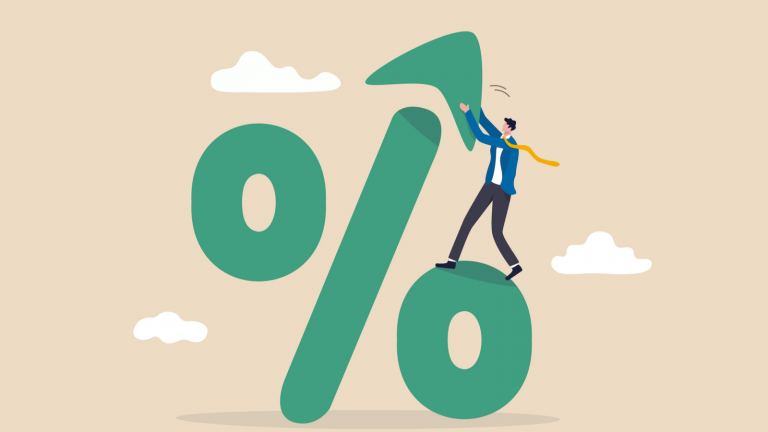
Source: eamesBot / Shutterstock
Editorial Note: InvestorPlace Beacon independently determines what we cover and recommend. We earn a commission from affiliate partners on many offers and links. However, these commissions do not affect our editors' opinions or evaluations. Click here to read our full advertiser disclosure.
The terms annual percentage yield (APY) and interest rate are often used interchangeably, but they do not mean the same thing. They both relate to how much money you can earn on your investments, including in a CD or savings account, but the APY gives a more accurate estimate. Learn about the differences between an APY and interest rate to get a better understanding of the potential earnings on your deposits and investments.
The Difference Between APY and Interest Rate
Think of interest rate as a factor in determining your APY. Your interest rate accounts for the interest earned on only your initial deposit.
APY, on the other hand, is a more precise calculation of your earnings. According to the Consumer Financial Protection Bureau, APY is the actual rate of return earned within one year if the interest is compounded. Banks typically display their savings rates as APYs.
| Fast Fact |
| While simple interest is only interest earned on your initial deposit, compounded interest is interest on your interest, along with your initial deposit. |
Your interest can be compounded daily, monthly or quarterly. Ask your bank how each account compounds interest to avoid any surprises.
Now that you understand the basics of APY and interest rates, it’s time to learn how to calculate your APY and interest rates for an earnings estimate.
APY vs. Interest Rate Example
Savings rates are fairly easy to calculate as long as you have your initial deposit and interest rate. The example below determines how much you’d earn within one year with a 4% interest rate and $1,000 deposit.
Interest Rate Example
| If you make a deposit of: | $1,000 |
| With an: | interest rate of 4% paid after one year |
| You’d earn: | $40 in interest after one year |
APY, on the other hand, requires a bit more math to calculate.
For this example, let’s say you’re depositing $1,000 into a savings account with a 4% APY that compounds monthly.
The following five steps will help you determine the APY.
APY Formula
- Divide your APY (in this case 0.04) by 12 (number of months in a year). In this example, it would be 0.00333.
- Multiply that number (0.00333) by your initial deposit ($1,000), and you’d get $3.33.
- Meaning, you’d earn $3.33 on your initial deposit of $1,000 after one month. But we aren’t done yet. With APY, you also need to calculate the compounding interest for the next 11 months.
- Do this by multiplying your monthly interest (0.00333) by your initial deposit plus your newly earned interest (in this case $1,003.33). With this, you’ll get $3.34. Meaning, by the second month, you’ve earned $6.64 in interest.
- To figure out the remaining 11 months of APY earnings, continue multiplying your principal interest plus your newly earned interest by your APY (in this case 0.00333). The chart below breaks down the month-by-month earnings for this example.
APY Earning by Month Example
| Month | Interest Earned | Initial Deposit + Compounded Interest |
| 1 | $3.33 | $1,003.33 |
| 2 | $3.34 | $1,006.64 |
| 3 | $3.35 | $1,009.99 |
| 4 | $3.36 | $1,013.35 |
| 5 | $3.37 | $1,016.72 |
| 6 | $3.38 | $1,019.70 |
| 7 | $3.40 | $1,023.10 |
| 8 | $3.41 | $1,026.51 |
| 9 | $3.42 | $1,029.93 |
| 10 | $3.43 | $1,033.36 |
| 11 | $3.44 | $1,036.80 |
| 12 | $3.45 | $1,040.25 |
By the end of the year, your new balance would be $1,040.25. Remember that this example doesn’t account for additional contributions, and that the interest is compounded monthly. Interest can be compounded monthly, daily or even quarterly.
If you plan to make regular contributions to your accounts, you can expect higher earnings by the end of the year.
How APY and Interest Rate Works With Different Financial Products
Generally, most high-yield savings accounts, money market accounts and certificates of deposit (CDs) display their rates as APYs, not the simple interest rate.
High-yield savings accounts and money market accounts display their APYs upfront. In 2024, the rates on some of the best high-yield savings and money market accounts are around 5%.
However, CD’s APYs can be a bit misleading. CD’s have term lengths, which indicate how long your funds have to sit in the account (withdrawing early means facing penalty fees). CD terms usually last between six months and five years.
Let’s say you see a 6-month CD with a 5% APY. Remember, the APY is the actual rate of return earned within one year. So while you may assume you’d earn 5%, because the CD is only active for six months, you would actually only earn 2.5%.
If you need further clarification on how interest rates and APY work, consider speaking with a licensed financial advisor before opening an investing or savings account.
Sources:
Consumer Financial Protection Bureau. (n.d.). Appendix A to Part 1030 — Annual Percentage Yield Calculation. Retrieved from https://www.consumerfinance.gov/rules-policy/regulations/1030/a/



